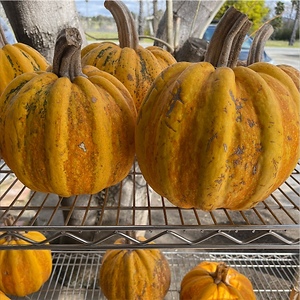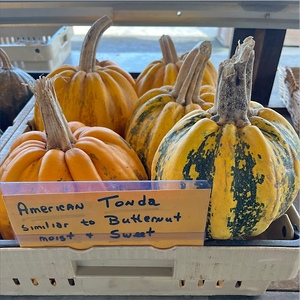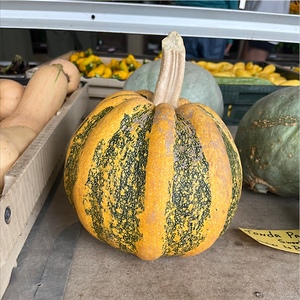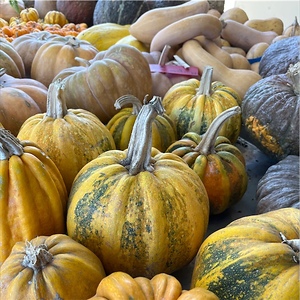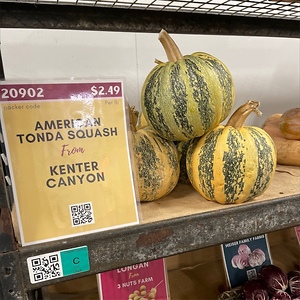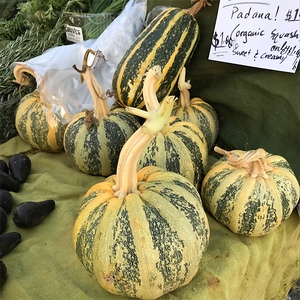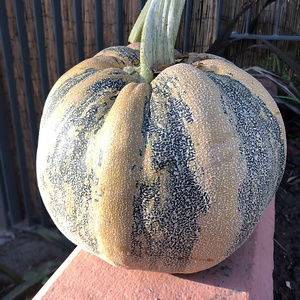

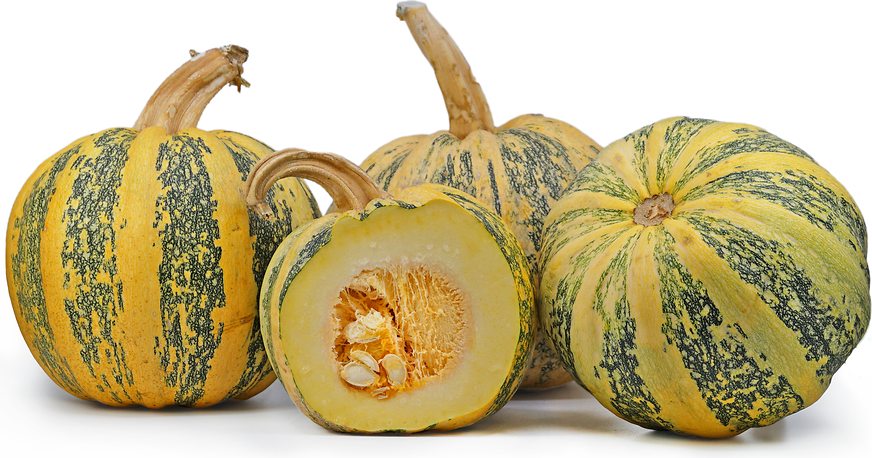
American Tonda Squash
Estimated Inventory, lb : 0
Description/Taste
The American Tonda squash is small to medium in size with a round to oblong shape and a light beige, rough, and ridged stem. The rind is firm, thick, and has a dark green base with light green and orange-yellow mottling with alternating grey and green stripes along prominent ribbing that spans the length of the squash. As the squash matures, the coloring will take on an increasingly yellow and orange hue. The flesh is yellow, moist, and spongy with a hollow center containing stringy pulp that encases many flat cream-colored, hard seeds. When cooked, the American Tonda squash is dry, transforms to orange in color, and offers a sweet squash flavor similar to that of butternut squash.
Seasons/Availability
The American Tonda squash is available in the fall and winter.
Current Facts
The American Tonda squash, botanically classified as Cucurbita pepo ‘American Tonda,’ is an Italian winter squash that grows on a vining plant and is a part of the Cucurbitaceae family along with pumpkins and gourds. Despite the American title in its name, the American Tonda squash was named after its resemblance to the classic American pumpkin and originated in Italy. Also known as Tonda Padana, Americana Tonda, and American Tondo, the American Tonda squash is a visually unique variety that was popular in the mid-nineteenth century and has recently been making a comeback. Known for its ornamental attributes as much as its culinary abilities, the American Tonda is a specialty squash that can be found at farmers markets and select stores when in season. It can be consumed raw when harvested young and immature, similarly to zucchini, or it can be left on the vine to mature and harvested when hard and dense, similar to butternut squash.
Nutritional Value
The American Tonda is an excellent source of beta-carotene which is converted into vitamin A by the body. Vitamin A helps protect healthy skin functions, good eye health, and is also responsible for the vibrant coloring of the squash’s flesh.
Applications
The American Tonda squash is best suited for cooked applications such as steaming, roasting, baking, or grilling. It can be cut into cubes, wedges, or in half and roasted or steamed to be served as a side dish or used to make soups, sauces, and sweet preparations such as pies, muffins, and bread. Peeled and cubed squash can also be added to pasta, gnocchi, and risotto or used as a stuffing for empanadas, calzones, risotto, or casseroles. The skin of the squash is too tough for consumption and should be removed either before or after cooking. The American Tonda squash pairs well with fresh herbs such as parsley, sage, and basil, gorgonzola, parmesan cheese, curry spice, cinnamon, nutmeg, browned butter, maple syrup, apple, pear, toasted hazelnuts, raisins, dried cranberries, and pancetta. It will keep up to a month when stored in a cool and dry place.
Ethnic/Cultural Info
Believed to be an Italian variety, the American Tonda squash, also known as Tonda Padana, gets its name from the Italian word for round (tonda) and from the Po or Padania Valley, the region where the squash is believed to have originated. In Italy, the squash is most popularly used to make gnocchi and is the key ingredient in fillings for other homemade pasta dishes. The American Tonda squash is also very similar in appearance and may be a relative of the New Zealand squash popularly used by the Maori known as kumi kumi or kamo kamo squash.
Geography/History
The American Tonda squash is believed to have been developed in the Padania region of north-western Italy. Today the American Tonda squash is available in limited quantities at specialty grocers and farmers markets in Europe and the United States.
Recipe Ideas
Recipes that include American Tonda Squash. One
| Mister Meatball |
|
Pumpkin Ricotta Squash |



